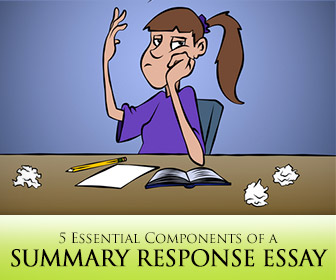
The Summary Response essay is a classic writing task for advanced English as a Second Language Students who are embarking on an academic path.
It is often used to introduce students to the notion of source integration, and it can also serve as a foundation for introducing other rhetorical styles. As students prepare to undertake university coursework, they need to be prepared to respond to reading material responsibly and effectively, and the summary response essay is excellent way to help them begin to learn how to do so.

Prepare Your Students for Academic Writing
-
1
Summarizing
This writing task is a fundamentally important one, as it will be a useful and necessary technique in many academic writing assignments that ESL students encounter in their studies. It’s especially challenging because a student’s ability to do so effectively depends on both reading and writing skills. If students are at a deficit in reading proficiency, the writing aspect of summarizing will be incredibly difficult. Likewise, if a student is strong reader, summarizing will be challenging if his or her writing skills are not of a comparable proficiency level. When teaching students how to summarize, the focus should be on main ideas. Often, students are tempted to include too many details, and a summary can turn into one long paraphrase in which students include too many details. A summary grid is a useful tool for helping students to pull main ideas out of a text before organizing them into a piece of writing. This graphic organizer is simply a chart that has space for students to write the main idea of portions of the text. It can be divided by sentence, paragraph, or section, depending on the length of the text. Students can use a summary gird to take notes and then further synthesize the information to decide what to include in a summary. Like anything we teach, summarizing needs to be broken down step by step when students first are first beginning to learn how to do so, and collaboration among classmates when students are first learning this concept will be very useful.
-
2
Paraphrasing and Quoting
There can easily be confusion between summarizing, paraphrasing, and quoting when students are learning to integrate sources into their writing. Therefore, it is often helpful to introduce these skills together, allowing students to compare and contrast the characteristics of each. Start by taking a passage and showing students an example of a summary, a paraphrase, and quote from the same excerpt, so they can begin to identify the defining features of all three. The focus of summaries should be on main ideas, which paraphrasing and quoting should preserve one, isolated idea in its entirety.
-
3
Organization
The organization of a summary response essay is typically a 4-5 paragraph essay that includes a short summary in the introduction that provides and objective overview of a text. The body of the essay is the response portion and should include student’s commentary on the reading or on an issue related to the topic or ideas stated within the reading. This format is a formative teaching tool because much of what students will encounter in later academic coursework will require them to engage in writing tasks that require stating information and then analyzing it. The summary response essay serves a stepping stone for this kind of thinking and writing process, and thus, the organization of ideas in a summary response essay is important as a foundational form.
-
4
Transitions
The summary response essay, like any basic writing task for English as a Second Language students, is also an opportunity to develop cohesion in writing. Students should be directed to choose appropriate connectors to join ideas, both between paragraphs and within them. Once students have mastered the general format of a summary response essay, the next step is to have them refine their writing by looking at how appropriate transitional words and phrases can be added to aid them in clarifying ideas and creating stronger arguments.
-
5
Argumentation Can Be Introduced
When students have become comfortable using the summary response format, argumentation can be introduced using the same structure. This allows students to focus on dealing with their ideas without needing to also worry about organizational issues in the essay. If they are working within the familiar framework of the summary response essay, they will be free to explore how concession and refutation can be used to strengthen opinions and enhance critical thinking. Argumentation is a concept that will take students some time to digest, so if students can work within a familiar framework, it minimizes the amount of new information that needs to be processed at once.
The summary response essay is a tried-and-true tool for developmental English as a Second Language writing and reading courses.
It is an essential component of any course that is preparing students to write academically with the use of source integration. Students will benefit greatly throughout their academic careers from the practice that the summary response essay affords them in terms of honing their summarizing, paraphrasing, and quoting skills.
P.S. If you enjoyed this article, please help spread it by clicking one of those sharing buttons below. And if you are interested in more, you should follow our Facebook page where we share more about creative, non-boring ways to teach English.







